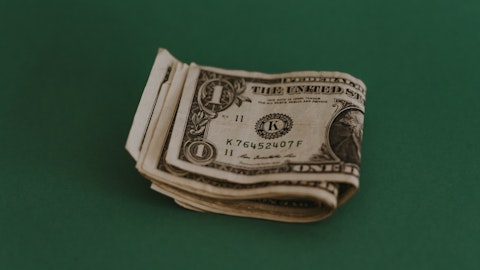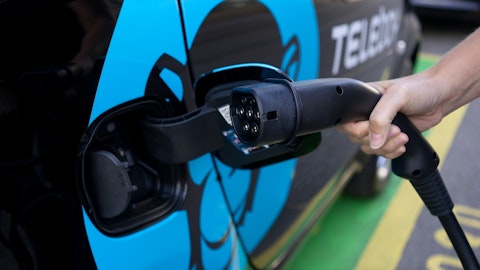David Raso: Even — maybe can you update us on the mix of your end markets? It feels like the consolidated off-highway, the construction exposure you have that shows up in the P&L more so than JV, and the JV is more of the on-highway. I’m surprised with the mix because that construction business at this stage must be pretty small after the declines we’ve seen. So, to have truck up double digit for China, for heavy and light, even though the excavator is down a lot, the mix would suggest you’d be up more than 7%, if truck is up double digit and at now relatively small construction business is down. Are there other businesses keeping it only at 7%? Is there a share comment there? Just trying to understand why only up 7% with that China end market guide?
Mark Smith: I don’t think there’s anything significant in there, David. I mean, obviously, whether it’s consolidated or unconsolidated, trucks probably plus when you add up all of our markets. So, the truck does better, we’ll be up more than 7%. If it doesn’t, we won’t. I think for components, that’s all consolidated revenue. That’s almost entirely on-highway. It’s really the engine business that has the off-highway business of any of any size. And then, yes, I think Power Systems has been pretty strong last year in China. It has probably been the exception to what we’ve seen in every other market. But there’s no big change in dynamics.
Jennifer Rumsey: Just on your share, we expect to continue to grow our share in the China market with the launch of the NS VI product. So, that’s assumed in our guidance.
David Raso: I’d even think with some of the transmissions as well. So, I’m just trying to understand like Photon is struggling more than I would have thought. It’s still barely making money now for two quarters in a row. Is there something about that dynamic we should be more sensitive to on the margin recovery in China in the JV because of Photon?
Mark Smith: No. We did get some sizable tech fees and other things from the early part of last year, which kind of helped — the wrong word, we were entitled to those based on product launches, but no, I don’t think there’s anything significant there.
David Raso: And I’ll hop off, just one kind of modeling question. If you take the interest expense in the fourth quarter and annualize it, it’s $348 million. You mentioned there’s debt reduction, but your guide is $380 million. I mean, what are we assuming for interest rates from the fourth quarter on to have up interest expense, but you’re targeting debt reduction?
Mark Smith: Right. So, I think the answer to that is, we’ll need to keep working that down. I think we’ve got some floating rate exposure. It’s not all fixed, and probably, the debt reduction will come in the second half of the year, but let me come back to you on that, David.
Operator: The next question is coming from Rob Wertheimer of Melius Research. Please go ahead.
Rob Wertheimer: Hi. I know it’s still early days, but you’re starting to see some ramp in electrolyzers. And I guess there’s obviously a lot of uncertainty as to what the ultimate margin structure is going to be, New Power or clean energy generally. So I wonder if you have any thoughts on when you see clarity, any thoughts on where gross margins might trend. Maybe you’re still heavily investing, but the gross margins are improving, or just your thoughts on how the curve of profitability is shaping up in clean tech.
Jennifer Rumsey: Yes, the electrolyzer business is really going to drive the majority of our progress towards breakeven in 27 for New Power and the growth aspirations that we shared for 2030. And so, we expect during that time frame to scale up the product, the supply chain and manufacturing and continue to see growing backlog and conversion of orders into revenue. And so through that time period, you’ll see margins going positive and improving, the exact margin structure of that business is still unclear. There’s not a lot of suppliers in the market, and we expect demand to be quite strong through that time period. So, I’m optimistic on what margin structure for the business will look like. But, obviously, we’ll share more as we get towards that breakeven point and go margin positive.
Mark Smith: Yes. Rob, one thing I’ll add is, for the gross margin on a project basis, we’re at gross margin positive last year, which is a good early indicator. We have other costs that are going in, too, for capacity expansion and other things that obviously offsets that, but it’s a good indicator that we’re on the right path for profitability as we move forward with more volume.
Rob Wertheimer: Okay. That’s helpful. Thank you. And obviously, there’s just still a lot of build-out in manufacturing and supply chain. So, do you have a sense as to how you stack up competitively on either design cost, or I guess you have a lot of advantages in manufacturing as you build out and off the top there.
Jennifer Rumsey: I mean one of the advantages we have here is we’re able to leverage our existing footprint and capability that we have as a part of the broader comment. So, you saw us announce recently, we plan to use our Fridley manufacturing facility for electrolyzer production in North America. So, we are tapping into that strength we have in our footprint and supply chain capability to help build out profitable both product as well as supply chain. And that’s an advantage that I think Cummins has here.
Operator: The next question is coming from Nicole DeBlase of Deutsche Bank. Please go ahead.
Nicole DeBlase: Maybe just on the distribution margins. It looks like you guys aren’t expecting margin expansion there, even though sales are up 2% to 7%. I guess what is the reason for that?
Mark Smith: I think there’s a little bit of improvement baked into the guidance, but we’ve got a pretty strong track record of improving. There’s no structural impediments to growing margins over time. It’s a range. So, under the different revenue scenarios, some variation, Nicole. But over the time, we expect the margins to keep going up.
Nicole DeBlase: Okay, understood. Thanks. And then I guess Power Systems stood out to me. On the other side, it’s just the margins look really impressive year-on-year in 2023. Is price/cost the biggest driver of that, or is there any other big drivers of the margin expansion that you guys are expecting?
Mark Smith: I think, certainly, that’s been a big factor, and we’ve got pretty healthy demand locked in now. So, there’s been a lot of focus on that business. We’ve been pleased with the solid results, particularly in the second half of this year, and we just — we’ve got a very, very strong focus on continuing to drive
Jennifer Rumsey: For that business, it’s important to keep in mind, you see a very long — we have a very long lead time on orders. So, as costs accelerated, it took a while for us to pass on some of the price increases to offset that, and that is in part what drove the strong margin improvement from 21 to 22.
Operator: The next question is coming from Matt Elkott of Cowen. Please go ahead.





